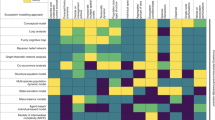Summary
Although the linear relationships characterizing an ecosystem, e.g., nutrient fluxes and pathways of energy flow, may be obtained experimentally or known a priori, these alone are insufficient to yield a model which behaves realistically; the non-linear relationships between system variables must also be incorporated. However, even though a non-linear relationship between two system variables is suspected there exists no formal approach whereby one might experimentally verify the presence of such a non-linear relation, assess the magnitude of its influence, and formulate the relation in a functional notation suited to incorporation into the system model.
In this paper it is shown that for those systems amenable to kinetic tracer incorporation experiments it is possible to estimate a parameter which quantitatively states the effect of a non-linear relationship between the two system variables.
The approach requires that some one variable of the system is capable of being maintained at a constant value during the course of a tracer kinetic incorporation experiment; i.e., may be employed as an independent variable. A set of experiments is conducted in which a single component of the system is labelled and the time-varying radioactivities of the remaining system components are measured as are the component values themselves. The experiments differ only in the value at which the independent system variable is maintained. From each experiment, one obtains a set of time-varying curves of component radioactivities which are resolved into sums of exponentials by a global fitting strategy. The component values and the exponents obtained in the set of experiments provide the data required to estimate the non-linear system parameter.
To demonstrate the validity of this approach tracer kinetic experiments were simulated for two different cases. The models employed in each of the simulated cases were identical in all respects but one. In one case the model system contained a non-linear relationship in the form of a negative feedback loop. In the other case, the model lacked this non-linearity.
The proposed analysis was applied to both cases and yielded the parameter values consistent with each case. Thus the analysis is capable of demonstrating the absence of a non-linear relationship presumed to exist between system components.
Similar content being viewed by others
References
Chestnut, H., Mayer, R. W: Servomechanisms and regulating system design, 2nd ed. New York: Wiley 1961
Matis, J. H., Hartley, H. O.: Stochastic Compartmental Analysis: Model and least squares estimation from time series data. Biometrics 27, 77–102 (1971)
May, R. M.: Limit cycles in predator-prey communities. Science (N.Y.), 177, 900–902 (1972)
Novick, A., Szilard, L.: Experiments with the chemostat on spontaneous mutations of bacteria. Proc. nat. Acad. Sci. (Wash.), 36, 708–719 (1950)
O'Connor, J. S., Patten, B. C.: Mathematical models of plankton productivity. Reservoir Fishery Resources Symposium, Athens, Georgia, April 5–7, p. 207–228 (1967)
Parker R. A.: Simulation of an aquatic ecosystem. Biometrics 24, 803–821 (1968)
Savageau, M. A.: Biochemical systems analysis. II. The steady-state solutions for an n-pool system using a power-law approximation. J. theor. Biol. 25, 370–379 (1969)
Smith, D. F.: Monodisperse suspensions of synchronous cells in a defined medium of unchanging composition. Exp. Cell Res. 57, 251–256 (1969)
Smith, D. F.: Quantitative analysis of the functional relationships existing between ecosystem components. I. Analysis of the linear intercomponent mass transfers. Oecologia (Berl.) 16, 97–106 (1974)
Usher, M. B.: Developments in the Leslie matrix model. In: Mathematical models in ecology, J. N. R. Jeffers, Ed., p. 29–60. Oxford: Blackwell 1972
Wagner, J. G.: Pharmacokinetics. A. Rev. Pharmac. 8, 67–94 (1968)
Walsh, J. J.: Implications of a systems approach to oceanography. Science (N.Y.) 176, 969–975 (1972)
Walsh, J. J., Dugdale, R. C.: A simulation model of the nitrogen flow in the Peruvian upwelling system. Invest. pesq. 35, 309–330 (1971)
Watt, K. E. F.: Use of mathematics in population ecology. A. Rev. Ent. 7, 243–260 (1962)
Williams, F. M.: Dynamics of microbial populations. In: Systems analysis and simulation in ecology, B. C. Patten, Ed., vol. 1, pp. 197–267. New York: Academic Press 1971
Williams, R. B.: Computer simulation of energy flow in Cedar Bog Lake, Minnesota based on the classical studies of Lindeman. In: Systems analysis and simulation in ecology, B. C. Patten, Ed., vol. 1, p. 543–582. New York: Academic Press 1971
Wong J. T.-F., Hanes, C. S.: Kinetic formulations for enzymic reactions involving two substrates. Canad. J. Biochem. Physiol. 40, 763–804 (1962)
Author information
Authors and Affiliations
Rights and permissions
About this article
Cite this article
Smith, D.F. Quantitative analysis of the functional relationships existing between ecosystem components. Oecologia 16, 107–117 (1974). https://doi.org/10.1007/BF00345576
Received:
Issue Date:
DOI: https://doi.org/10.1007/BF00345576




